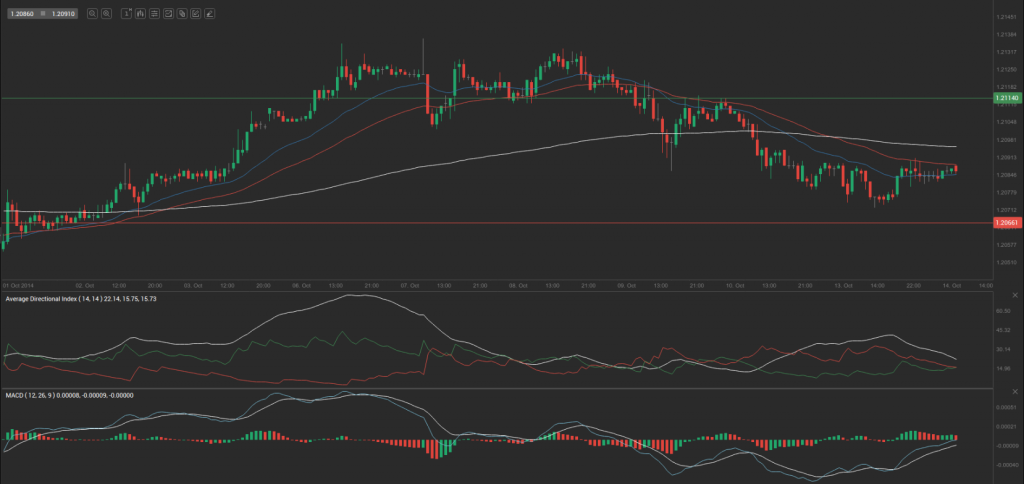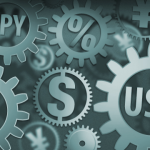Yesterday’s trade saw EUR/CHF within the range of 1.2067-1.2115. The pair closed at 1.2090, gaining 0.03% on a daily basis.
At 6:18 GMT today EUR/CHF was down 0.01% for the day to trade at 1.2088. The pair touched a daily low at 1.2084 during early Asian trade.
Fundamental view
Euro zone
French consumer inflation
The annualized index of consumer prices (CPI) in France probably remained unchanged at 0.4% in September, according to the median forecast by experts. If so, this would be the second month in a row, when the CPI stood at the lowest level since 2010. In August prices of tobacco rose at an annualized rate of 3.5%, transport and communication costs were up 2.1%, cost of other services climbed 2.2%, while prices of clothing and footwear rose 1.6%. Consumers paid less for fresh food (-8.9%), petroleum products (-3.3%), medical products (-2.9%) and food excluding fresh products (-0.4%), according to data by the INSEE.
Key categories, included in Frances Consumer Price Index, are manufactured products excluding clothing and pharmaceuticals (accounting for 20.6% of the total weight) and food (16.4%). Other categories, which comprise the index, are healthcare (10.1%), energy (8.7%), rentals and real estate services (7.4%), transport and communication services (5%), clothing and footwear (4.7%) and pharmaceuticals (4.6%).
The index measures the change in price levels of the above mentioned basket of goods and services from consumer’s perspective and also provides clues over purchasing tendencies. In case the CPI decelerated, this would have a bearish effect on the euro. The National Institute for Statistics and Economic Studies (INSEE) will release the official report at 6:45 GMT.
France’s annualized CPI, evaluated in accordance with Eurostat’s harmonized methodology, probably fell to 0.4% during September from 0.5% in August and 0.6% in July. In monthly terms, the harmonized CPI probably fell 0.2% last month, following a 0.5% increase in August.
Spanish consumer inflation – final
Spain’s final annualized index of consumer prices (CPI) probably improved to -0.2% in September, confirming the preliminary CPI reading, reported on September 29th. In August the annualized CPI was at -0.5%. If confirmed, this would be the third consecutive month of negative inflation rate. According to provisional estimates, cost of food and non-alcoholic beverages were flat on a yearly basis in September, while electricity prices rose.
Key categories, included in Spans CPI, are food and non-alcoholic beverages (accounting for 20% of the total weight) and transport (15%). Other categories are real estate (12%), hotels, coffee and restaurants (11.5%), clothing and footwear (9%) and entertainment and culture (7.5%). Health, communication, education and other goods and services comprise the remaining 25% of the index.
The CPI measures the change in price levels of the abovementioned basket of goods and services from consumer’s perspective and also provides clues over purchasing trends. In case the CPI dropped more than projected, this would have a bearish effect on the common currency. The National Statistics Institute (INE) will release its official report at 7:00 GMT.
Spanish final annualized CPI, evaluated in accordance with Eurostat’s harmonized methodology, probably also matched the preliminary CPI estimate of -0.3% in September, which was released on September 29th. Augusts HICP reading stood at -0.5%.
Italian consumer inflation – final
Italys final annualized index of consumer prices (CPI) probably remained steady at -0.1% in August, matching the preliminary CPI, reported on September 30th. If so, this would be the second month in 55 years, when Italian consumer inflation was in negative territory. According to provisional estimates, the drop in consumer prices was mostly driven by lower prices of non-regulated energy products (a 2.8% annual drop in September), followed by a 0.9% decrease in the cost of unprocessed food.
Key categories, included in Italys Consumer Price Index, are food and non-alcoholic beverages (accounting for 16% of total weight), transport (15%), restaurants and hotels (11%) and housing, water, electricity and other fuels (10%). Other categories are clothing and footwear (9%), furnishing and household equipment (8%), recreation and culture (8%) and health (also 8%). Communication, education, alcoholic beverages, tobacco and other goods and services comprise the remaining 15% of the index.
Nations final annualized CPI, evaluated in accordance with the harmonized methodology, probably matched the preliminary HICP estimate of -0.2% in September, which was released on September 30th. The National Institute of Statistics (ISTAT) is to publish the official CPI report at 8:00 GMT.
Germany and Euro zone Economic Sentiment by the ZEW Institute
The gauge of economic sentiment in Germany probably continued to fall, reaching 1.0 in October, according to the median forecast by experts. In September the index came in at 6.9. The indicator has been falling since December 2013, when it stood at 62.0. Geopolitical situation probably continued to have an adverse influence on economic expectations.
The ZEW (Zentrum für Europäische Wirtschaftsforschung) economic expectations index is published monthly. The study encompasses up to 350 financial and economic analysts. The indicator reflects the difference between the share of analysts, that are optimistic and those, that are pessimistic about the expected economic development in Germany over the next six months. A positive value indicates that the proportion of optimists is larger than that of pessimists. A ZEW reading of -100 suggests that all analysts are pessimistic about the current developments and expect economic conditions to deteriorate. A ZEW reading of 100 implies that all analysts are optimistic about the current situation and expect conditions to improve. A ZEW reading of 0 indicates neutrality.
The index of current assessment in Germany probably dropped to 18.4 in October from 25.4 in the prior month.
The ZEW Economic Sentiment index in the Euro zone probably fell to 2.5 this month from 14.2 during September.
Lower-than-projected readings would certainly cause a negative impact on the single currency. The official data is scheduled to be released at 9:00 GMT.
Euro zone industrial production
The seasonally adjusted index of industrial production in the Euro zone probably dropped 1.8% in August compared to a month ago, following a 1.0% increase in July, as the latter has been the most considerable monthly gain since October 2013. Annualized output probably contracted at a pace of 0.9% in August. The index, reflecting the business cycle, measures the change in overall inflation-adjusted value of output in sectors such as manufacturing, mining and utilities. In case industrial output shrank more than anticipated, this would mount selling pressure on the euro. Eurostat is to publish the official data at 9:00 GMT.
Switzerland
The index of producer and import prices in Switzerland probably declined 1.4% in September from a year ago, according to the median experts’ estimate. In August the index fell at an annualized rate of 1.2%, which has been the most significant decrease since April. The index consists of two sub-indexes, the producer price index (PPI) and the index of import prices (IIP). The PPI refers to goods produced and sold domestically or exported by Swiss companies. Goods includes raw materials, starting materials, semi-finished and finished products. Prices of goods are measured at the first marketing step in the production of the good, as the VAT is not included. The IIP has a similar structure to that of producer prices, reflecting the prices of imported goods (price before duty, VAT). The combined index of producer and import prices generally reflects changes in both indexes, by summing up their values.
The Swiss Federal Statistical Office is scheduled to release the official figures at 7:15 GMT. Worse-than-expected performance would lead to a sell-off in the Swiss franc.
Technical view
According to Binary Tribune’s daily analysis, the central pivot point for the pair is at 1.2091. In case EUR/CHF manages to breach the first resistance level at 1.2114, it will probably continue up to test 1.2139. In case the second key resistance is broken, the pair will probably attempt to advance to 1.2162.
If EUR/CHF manages to breach the first key support at 1.2066, it will probably continue to slide and test 1.2043. With this second key support broken, the movement to the downside will probably continue to 1.2018.
The mid-Pivot levels for today are as follows: M1 – 1.2031, M2 – 1.2055, M3 – 1.2079, M4 – 1.2103, M5 – 1.2127, M6 – 1.2151.
In weekly terms, the central pivot point is at 1.2104. The three key resistance levels are as follows: R1 – 1.2134, R2 – 1.2175, R3 – 1.2205. The three key support levels are: S1 – 1.2063, S2 – 1.2033, S3 – 1.2000.






